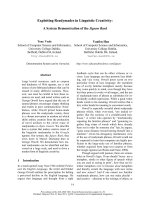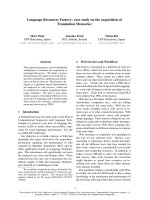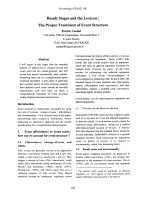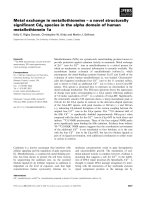Báo cáo khoa học: "Gas exchange in young Scots pine following pruning of current shoots" pot
Bạn đang xem bản rút gọn của tài liệu. Xem và tải ngay bản đầy đủ của tài liệu tại đây (505.28 KB, 8 trang )
Original
article
Gas
exchange
in
young
Scots
pine
following
pruning
of
current
shoots
E Troeng
B
Langström
1
Swedish
University
of
Agricultural
Sciences,
Department
of
Ecology
and
Environmental
Research,
Box
7072,
S-750
07
Uppsala;
2
Swedish
University
of
Agricultural
Sciences,
Division
of
Forest
Entomology,
S-770
73
Garpenberg,
Sweden
(Received
8
November
1990;
accepted
12
February
1991)
Summary —
A
pine
shoot
beetle attack
was
simulated
by
cutting
all
current
shoots
in
the
upper
crown
of
2
20-yr-old
Scots
pines
(Pinus
sylvestris
L)
while
gas
exchange
was
followed
continuously
before
and
after
the
shoot
removal.
Net
photosynthetic
rate
and
mesophyll
conductance
of
the
2-yr-
old
shoots
decreased
by
=
50%
immediately
after
pruning
but
recovered
within
10
d
after
the
shoot
removal.
The
quantum
yield
was
also
much
lower
after
cutting.
Water
status
and
transpiration
rate
were
not
systematically
affected
by
the
treatment.
Possible
explanations
of
the
photosynthetic
decrease
could
be
an
accumulation
of
assimilation
prod-
ucts
decreasing
the
mesophyll
conductance
of
carbon
dioxide
to
the
chloroplasts
or
changes
of
the
carbon
allocation
pattern.
Scots
pine
/
shoot-pruning
/
photosynthesis
/
quantum
yield
/
field
performance
Résumé —
Échanges
gazeux
chez
des
jeunes
pins
sylvestres
après
élagage
des
pousses
de
l’année.
Une
attaque
du
scolytide
Tomicus
piniperda
a
été
simulée
en
coupant
toutes
les
pousses
de
l’année
dans
la
partie
supérieure
de
la
couronne
de 2
pins
sylvestres
(Pinus
sylvestris
L)
de
20
ans.
Pendant
le
même
temps,
les
échanges
gazeux
ont
été
suivis
de
façon
continue
avant
et
après
l’opération.
Le
taux
net
de
photosynthèse
et
la
conductance
du
mésophylle
des
pousses
de
un an
décroît
d’environ
50%
immédiatement
après
l’élagage,
mais
récupère
dans
les
10 jours
suivant
le
re-
trait
des
pousses.
Le
rendement
quantique
diminue
aussi
beaucoup
après
la
coupe
des
pousses.
L’état
hydrique
et
le
taux
de
transpiration
ne
sont pas
affectés
systématiquement
par
le
traitement.
La
diminution
de
la
photosynthèse
pourrait
être
expliquée
par
une
accumulation
d’assimilats
ayant
pour
effet
de
diminuer
la
conductance
du
mésophylle
pour
le
dioxyde
de
carbone
vers
les
chloro-
plastes
ou
par
des
modifications
dans
le
shéma
d’allocation
du
carbone.
pin
sylvestre
/
élagage
des
pousses
/
photosynthèse
/
rendement
quantique
/
performance
sur
le
terrain
INTRODUCTION
It
is
known
that
insects
can
cause
growth
losses
in
forest
trees,
eg
by
consuming
fol-
iage
and
buds
(for
references,
see
Kulman
1971).
Besides
quantitative
losses
in
terms
of
reduced
stem
growth,
insect
ac-
tivity
also
has
qualitative
effects
on
physio-
logical
processes
in
the
tree.
Such
report-
ed
effects
include
increased
nitrogen
(Piene
and
Percy,
1984;
Ericsson
et
al,
1985)
and
reduced
carbohydrate
levels
(Ericsson
et al 1980a,
1985)
in
remaining
needles,
increased
photosynthetic
capaci-
ty
in
regrowth
foliage
(Heichel
and
Turner,
1983),
and
increased
amounts
of
defen-
sive
chemicals
such
as
tannins
and
phe-
nolics
(eg
Wagner,
1988).
It
has
also
been
suggested
that
water
and
light
conditions
for
remaining
foliage
may
at
least
tempo-
rarily
be
improved
as
a
result
of
defoliaton
(Ericsson
et al,
1980b).
Altogether,
some
of
these
physiological
changes
counteract
the
detrimental
effects
of
the
foliage
loss,
and
may
be
important
in
the
recovery
pro-
cess
of
the
defoliated
tree.
In
a
field
experiment
comparing
induced
beetle
attacks
on
caged
trees
and
artificial-
ly
pruned
trees,
both
treatments
produced
unexpectedly
small
growth
losses
in
young
Scots
pine
(Pinus
sylvestris
L)
trees
as
compared
to
previously
reported
natural
attacks
by
the
pine
shoot
beetle,
Tomicus
piniperda
(L)
(Coleoptera,
Scolytidae)
(Ericsson
et al,
1985).
The
pruning
pattern
as
well
as
the
induced
attacks
were
very
similar
to
the
attack
pattern
observed
un-
der
natural
conditions.
The
discrepancy
in
growth
reduction
as
compared
to
earlier
studies
was
thought
to
be
a
result
of
younger
trees
being
used
in
the
experi-
ment.
A
later
study
confirmed
that
older
trees
react
comparatively
more
strongly
to
needle
loss
than
young
trees
(Langström
et al,
1990).
Among
different
compensato-
ry
mechanisms
discussed
in
these
studies,
increased
photosynthetic
capacity
of
re-
maining
needles
was
hypothetically
con-
sidered
to
be
one
likely
explanation
for
the
observed
results.
Thus,
combining
such
a
simulated
attack
with
continuous
gas
ex-
change
measurements
in
trees
in
situ
could
improve
the
understanding
of
carbo-
hydrate
dynamics
and
growth
responses
of
attacked
trees.
To
test
this
hypothesis,
we
simulated
a
pine
shoot
beetle
attack
by
cutting
all
cur-
rent
shoots
in
the
upper
crown
of
2
20-yr-
old
Scots
pines
while
in
situ
gas
exchange
of
1-yr-old
needles
was
followed
continu-
ously
before
and
after
the
"attack".
MATERIAL
AND
METHODS
The
experiment
was
carried
out
in
a
20-yr-old
stand
of
Scots
pine
(Pinus
sylvestris
L)
situated
at
Jädraas,
Sweden
(60°
48’
N,
16°
30’
E,
alti-
tude
180
m).
The
stand,
growing
on
glacifluvial
sand,
has
been
described
by
Flower-Ellis
et
al,
(1976)
and
details
of
the
site
have
been
given
by
Axelsson
and
Brakenhielm
(1980).
Gas
exchange
was
measured
in
situ
by
an
open
system
with
cylindrical
assimilation
cham-
bers
made
of
thin
perspex.
The
chamber
was
at-
tached
to
a
base-plate
fixed
in
a
bifurcated
hold-
er,
which
enabled
the
chamber
to
be
mounted
in
the
natural
position
of
the
shoot
to
be
studied.
The
chamber
temperature
followed
ambient
temperature
by
an
air-cooling
system.
Carbon
dioxide
was
measured
by
an
infra-red
gas
ana-
lyzer
(UNOR
2,
Maihak,
Hamburg,
Germany)
and
water
vapour
concentration
by
dew
point
mirrors
(Walz
Mess-
und
Regeltechnik,
Effel-
trich,
Germany).
Air
temperature
was
measured
by
thermocouples
(copper/constantan)
and
pho-
ton
flux
density
was
recorded
by
quantum
me-
ters
(LI-190
Lambda
Instruments,
USA).
Each
chamber
was
provided
with
a
separate
quantum
meter
placed
horizontally
outside
the
chamber.
Rates
of
photosynthesis
and
transpiration
were
expressed
on
a
projected
needle
area
basis,
the
needle
area
of
each
branch
being
determined
at
the
end
of
the
experiment
by
a
leaf
area
meter
(LI-300,
Lambda
Instruments,
USA).
Stomatal
conductance
for
the
flux
of
carbon
dioxide
through
the
stomata
and
mesophyll
conduc-
tance
for
the
flux
from
the
stomatal
cavity
to
the
chloroplasts
were
calculated
according
to
Lud-
low
and
Jarvis
(1971).
Further
details
of
the
gas
exchange
measurement
system
are
given
by
Linder
et
al
(1980).
Gas
exchange
data
together
with
climatic
data
were
collected,
stored
and
processed by
a
computer
(PDP
11/40)
at
the
field
site
(cf Engelbrecht
et al,
1980).
Needle
water
potential
was
measured
occa-
sionally
(table
I)
with
pressure
chamber
tech-
nique
based
on
the
design
of
Waring
and
Cleary
(1967)
and
further
developed
by
Hellkvist
et
al
(1980).
For
these
measurements,
1-yr-old
nee-
dles
from
the
third
whorl
from
the
top
on
the
south
side
of
the
trees
were
collected
in
the
mid-
dle
of
the
day.
In
1982
budbreak
occurred
at
the
end
of
May.
Shoot
growth
finished
at
the
beginning
of
July
while
needles
reached
their
final
length
in
the
middle
of
August.
Three
trees
of
height
2.5-
2.8
m
standing
close
to
each
other
were
used
for
the
study.
Assimilation
chambers
were
mounted
on
last
year’s
needles
on
the
main
branch
axis
of
south-facing
branches
of
the
third
whorl
from
the
top.
Gas
exchange
measure-
ments
started
on
June
16,
1982
and
on
July
27,
most
current
shoots
of
the
6
uppper
whorls,
in-
cluding
the
branches
with
the
assimilation
cham-
bers,
were
pruned
from
2
of
the
trees
while
the
third
tree
was
kept
intact
as
a
control.
The
total
needle
biomass
was
thus
reduced
by
=
25%,
and
that
of
the
current
shoots
by
=
70%,
simulat-
ing
a
heavy
attack
of
the
pine
shoot
beetle.
The
clipping
procedure
has
been
described
in
detail
by Langstr6m
et
al
(1990).
Gas
exchange
was
then
followed
continuously
to
September
4th.
To
evaluate
gas
exchange
data,
the
average
diur-
nal
course
of
4
periods
of
10
d
before
and
after
pruning
as
well
as
daily
photosynthetic
input
were
calculated
for
each
branch.
The
apparent
quantum
yield
was
calculated
from
the
linear
part
of
the
photon
flux
density
response
curve
obtained
from
field
data.
The
daily
light
use
effi-
ciency
was
calculated
from
average
daily
values
of
photon
flux
density
and
the
net
CO
2
uptake
during
the
24-h
period,
thus
including
the
respi-
ration
losses
during
the
night
hours
(cf Troeng
and
Linder,
1982).
The
total
number
of
records
from
each
as-
similation
chamber
varied
between
3
100
and
3
335.
Separate
data
from
each
of
the
cham-
bers
were
collected
at
least
every
45
min
throughout
the
measurement
period
and
later
condensed
to
average
values.
By
comparing
gas
exchange
data
between
trees
and
between
periods
before
and
after
the
pruning
treatment,
some
general
information
was
obtained
con-
cerning
the
reactions
of
gas
exchange
to
a
large
reduction
of
needle
biomass.
RESULTS
The
period
before
shoot
pruning
was
char-
acterized
by
low
precipitation
and above
average
air
temperature
(cf Lindroth
1985).
Water
stress
in
the
stand
increased
slowly
during
July
and
reached
a
maximum
at
the
beginning
of
August,
as
indicated
by
par-
tial
stomatal
closure
and
midday
depres-
sion
(Troeng,
1985).
Precipitation
during
the
period
July
5-August
5
was
<
5
mm
and
soil
water
potential
(Jansson
and
Hall-
din,
1979)
at
the
end
of
July
was
≈ 0.1
MPa
in
the
layer
0-30
cm
(Lindroth,
1985).
The
water
stress
conditions
disappeared
after
40
mm
rainfall
on
August
6.
Daily
net
photosynthetic
performance
was
similar
for
the
3
shoots
during
the
pe-
riod
before
pruning
(fig
1).
The
control
shoot
had
slightly
higher
photosynthetic
performance
during
all
periods
before
July
27.
This
was
due
to
the
fact
that
photon
flux
density
was
=
10%
higher
for
the
con-
trol
branch
due
to
less
shading
from
sur-
rounding
trees.
Since
calculated
quantum
yields
from
photosynthetic
light
response
curves
from
each
tree
were
not
significant-
ly
different,
net
photosynthetic
efficiency
was
considered
to
be
equal
before
shoot
pruning.
The
records
of
daily
photosynthet-
ic
input
showed
a
drastic
decrease
during
the
first
days
after
pruning
(fig
1)
and
the
daily
quantum
yield
was
considerably
low-
er
for
the
cut
trees
during
the
first
10
d
af-
ter
shoot
pruning
(fig
2).
The
decrease
af-
ter
pruning
was
primarily
caused
by
low
photosynthetic
rates
towards
the
end
of
the
day
while
photosynthesis
during
morn-
ing
hours
was
similar
to
that of
the
control
(fig
3).
Transpiration
data
were
analysed
for
the
3
trees
before
and
after
pruning,
but
since
no
drastic
changes
nor
any
syste-
matic
trends
in
transpiration
were
found,
data
are
not
reported
in
detail
here.
Water
potential
measurements
(table
I)
indicated
a
similar
water
stress
situation
for
all
trees
before
shoot-pruning.
After
pruning,
the
control
tree
showed
slightly
lower
water
potential
records
while
the
general
water
stress
disappeared
after
the
heavy
rain
fall
on
August
6.
Calculated
conductances
showed
that
the
mesophyll
conductance
was
generally
lower
than
stomatal
conductance
and
was
the
limiting
factor
for
photosynthesis.
Aver-
age
stomatal
conductance
during
daytime
was
between
2
and
4
mm.s
-1
while
meso-
phyll
conductance
seldom
exceeded
1.5 mm.s
-1
.
This
was
in
accordance
with
earlier
results
obtained
on
the
same
stand
(Troeng
and
Linder,
1982).
Even
during
the
water
stress
period
in
the
end
of
July
mesophyll
conductance
was
lower
than
stomatal
conductance.
Daily
mean
values
of
mesophyll
conductance
decreased
con-
siderably
after
the
shoot
pruning
on
July
27,
but
increased
again
to
levels
before
pruning
within
10
d
(fig
4).
The
photosyn-
thetic
decrease
after
pruning
was
in
good
agreement
with
the
decrease
of
mesophyll
conductance
(cf figs
1,
4).
DISCUSSION
Previously,
a
similar
experiment
in
the
same
stand
demonstrated
that
photosyn-
thesis
of
current
shoots
under
attack
by
a
beetle
declined
drastically
as
a
result
of
wilting
of
the
damaged
shoot,
whereas
the
1-yr-old
needles
on
the
same
axis
reacted
with
reduced
photosynthesis
soon
after
the
collapse
of
the
current
shoot
(Troeng
et
al,
1979).
In
the
present
study,
where
we
cut
the
current
shoots,
we
observed
a
similar
dras-
tic
but
transient
drop
in
photosynthesis
and
mesophyll
conductance.
Apart
from
cutting
the
shoots
instead
of
using
beetles,
the
main
difference
was
the whole-tree-
approach
in
the
present
study
as
com-
pared
to
one
single
attack
in
the
previous
study.
However,
knowing
the
indepen-
dence
of
individual
branches
(Langström
et
al,
1990),
the
similar
outcome
of
the
2
studies
is
not
surprising.
Simulating
a
pine
shoot
beetle
attack
by
artificial
pruning
has
been
shown
earlier
to
be
a
good
mimic
of
natural
attacks
(Ericsson
et
al,
1985;
Langström
et al,
1990).
One
possible
explanation
for
the
de-
crease
in
photosynthesis
after
pruning
could
be
the
carbon
balance
of
the
tree.
It
is
known
from
other
investigations
in
the
same
stand
(Ericsson,
1978;
1979)
and
elsewhere
(Senser
et
al,
1975)
that
current
needles
accumulate
starch
as
long
as
they
are
still
growing.
As
needle
growth
finished
in
the
middle
of
August,
current
needles
were
still
a
strong
sink
at
the
time
of
prun-
ing
at
the
end
of
July.
Consequently,
when
the
current
shoots
were
cut
off,
the
main
sink
for
photosynthetic
products
of
1-yr-old
needles
disappeared
and
an
accumulation
of
carbohydrates
may
have
taken
place,
thereby
inhibiting
net
photosynthesis
(cf
Neales
and
Incoll,
1968).
Lake
(1967)
sug-
gested
that
assimilate
accumulation
may
decrease
mesophyll
conductance
and
Rackham
(1966)
has
stated
that
such
a
decrease
could
be
an
effect
of
accumulat-
ed
starch
grains
in
the
chloroplasts.
Thus,
this
source-sink
relationship
could
explain
the
decrease
of
photosynthesis
and
meso-
phyll
conductance
immediately
after
prun-
ing.
Also,
the
diurnal
pattern
of
photosyn-
thesis
during
the
days
after
pruning
(fig
3)
supports
this
hypothesis.
During
the
sec-
ond
10-d
period
after
cutting
photosynthet-
ic
rates
and
mesophyll
conductances
were
back
to
normal.
This
could
be
due
to
car-
bohydrate
transport
to
new
sinks
(eg
the
root
system),
thus
decreasing
accumulat-
ed
carbohydrates
in
the
source
needles.
However,
no
attempt
was
made
to
follow
the
carbohydrate
flow
or
carbohydrate
content
in
different
organs
of
the
trees.
Removing
most
current
shoots
de-
creased
the
transpiring
needle
area
con-
siderably
and
improved
the
water
balance
of
the
experimental
trees
as
shown
by
needle
water
potential
measurements
car-
ried
out
2
d
after
cutting.
Midday
values
of
needle
water
potential
of
1-yr-old
needles
were
then
≈ 0.2-0.3
MPa
lower
for
the
control
tree than
for
the
experimental
trees.
Unfortunately,
measurements
were
carried
out
only
once
before
shoot-
pruning,
the
results
being
similar
for
all
trees.
This
observation
is
supported
by
the
transpiration
data
which
did
not
indicate
any
differences
in
stomatal
conductance
between
the
trees
either
before
or
after
pruning.
Also,
it
is
known
from
the
same
stand
that
transpiration
and
stomatal
con-
ductance
between
individuals
vary
more
than
photosynthesis
(Troeng
and
Linder,
1982).
Thus
the
most
likely
conclusion
is
that
the
marked
decrease
in
net
photosyn-
thesis
of
the
experimental
trees
just
after
cutting
was
not
caused
by
water
stress,
but
merely
by
the
shoot
pruning
treatment.
Similar
results
have
been
obtained
for
de-
foliated
trees
in
the
same
stand
(Ericsson
et al, 1980b).
After
partial
defoliation,
remaining
leaves
or
needles
may
increase
their
pho-
tosynthesis
(Maggs,
1965;
Sweet
and
Wa-
reing,
1966).
Heichel
and
Turner
(1983)
found
that
regrowth
foliage
of
defoliated
maples
displayed
increased
photosynthe-
sis
capacity.
On
the
other
hand,
King
et
al
(1967)
has
suggested
that
photosynthesis
of
a
specific
wheat
leaf
can
be
regulated
by
the
demand
for
assimilates
from
that
leaf.
In
such
a
case
a
low
demand
due
to
loss
of
a
strong
sink
would decrease
pho-
tosynthesis.
Our
results
support
the
latter
view.
Also,
the
results
of
a
previous
study
in
the
same
stand
support
the
same
hypothesis
(Troeng
et
al,
1979),
where
net
photosyn-
thesis
of
1-yr-old
needles
decreased
simul-
taneously
with
the
photosynthetic
collapse
of
the
beetle-attacked
current
shoot.
The
observed
decrease
in
photosynthesis
was,
however,
transient
and
may
well
have
been
compensated
for
by
a
possible
later
increase
in
net
photosynthesis
due
to
an
increase
in
needle
nitrogen
of
remaining
needles.
The
fertilizing
effect
of
shoot-
pruning
(ie,
a
clear
and
lasting
increase
in
needle
nitrogen)
has
been
documented
in
the
same
stand
(Ericsson
et
al,
1985;
Langström
et al,
1990),
as
has
the
relation-
ship
between
needle
nitrogen
concentra-
tion
and
photosynthetic
performance
(Lind-
er
and
Ingestad,
1977).
Since
no
increase
of
net
photosynthesis
was
observed
in
the
cut
branches
towards
the
end
of
the
study
period
we
postulate
that
the
possible
com-
pensatory
photosynthetic
effect
develops
more
slowly
than
the
increase
in
needle
ni-
trogen
(cf Langström
et al,
1990).
This
is
in
contrast
to
defoliation
experiments
where
remaining
needles
reacted
with
an
in-
creased
uptake
of
14
C
within
a
week
after
needle
removal
(Ericsson
et
al,
1980b).
Hence,
the
different
photosynthetic
reac-
tion
to
defoliation
as
compared
to
shoot
pruning
may
be
caused
by
other
reasons.
In
conclusion,
we
found
a
drastic
but
transient
decrease
in
photosynthetic
per-
formance
and
a
minor
improvement
in
wa-
ter
status
of
the
shoot-pruned
trees.
No
ev-
idence
of
increased
compensatory
photosynthesis
due
to
improved
nitrogen,
water
or
radiation
status
was
found
during
the
months
following
shoot
pruning.
Such
a
development
may
well
have
occurred
during
the
next
growing
season,
but
stud-
ies
did
not
cover
that
period.
ACKNOWLEDGMENTS
We
would
like
to
thank
C
Hellqvist
for
field
assis-
tance,
A
Lindroth
for
computer
assistance
and
F
Lieutier
for
helping
us
with
the
French
summary.
REFERENCES
Axelsson
B,
Brakenhielm
S
(1980)
Investigation
sites
of
the
Swedish
Coniferous
Forest
Pro-
ject-biological
and
physiographical
features.
In:
Structure
and
Function
of
Northern
Conif-
erous
Forests-An
Ecosystem
Study
(Pers-
son
T,
ed)
Ecol Bull 32,
25-64
Engelbrecht
B,
Lohammar
T,
Pettersson
L,Sundström
KB,
Svensson
J
(1980)
Data
handling
and
simulating
technique
used
in
the
Swedish
Coniferous
Forest
Project.
In:
Structure
and
Function
of
Northern
Conifer-
ous
Forests-An
Ecosystem
Study
(Persson
T, ed)
Ecol Bull 32,
65-71
Ericsson
A
(1978)
Seasonal
changes
in
translo-
cation
of
C-14
from
different
age-classes
of
needles
on
20-year-old
Scots
pine
trees
(Pi-
nus
sylvestris).
Physiol
Plant
43,
351-358
Ericsson
A
(1979)
Effects
of
fertilization
and
irri-
gation
on
the
seasonal
changes
of
carbohy-
drate
reserves
in
different
age-classes
of
needles
on
20-year-old
Scots
pine
trees
(Pi-
nus
sylvestris).
Physiol
Plant 45,
270-280
Ericsson
A,
Larsson
S,
Tenow
O
(1980a)
Ef-
fects
of
early
and
late
season
defoliation
on
growth
and
carbohydrate
dynamics
in
Scots
pine.
J
Appl
Ecol 17,
747-769
Ericsson
A,
Hellkvist
J,
Hillerdal-Hagströmer
K,
Larsson
S,
Mattsson-Djos
E,
Tenow
O
(1980b)
Consumption
and
pine
growth -
hy-
potheses
on
effects
on
growth
processes
by
needle-eating
insects.
In:
Structure
and
Function
of
Northern
Coniferous
Forests-An
Ecosystem
Study
(Persson
T,
ed)
Ecol
Bull
32, 537-545
Ericsson
A,
Hellqvist
C,
Langström
B,
Larsson
S,
Tenow
O
(1985)
Effects
on
growth
of
sim-
ulated
and
induced
shoot
pruning
by
Tomi-
cus
piniperda
as
related
to
carbohydrate
and
nitrogen
dynamics
in
Scots
pine.
J
Appl
Ecol
22, 105-124
Flower-Ellis
JGK,
Albrektsson
A,
Olsson
L
(1976)
Structure
and
growth
of
some
young
Scots
pine
stands:
dimensional
and
numeri-
cal
relationships.
Swed
Conif
For
Project,
Tech
Rep
3, 1-98
Heichel
GH,
Turner
NC
(1983)
CO
2
assimilation
of
primary
and
regrowth
foliage
of
red
maple
(Acer
rubrum
L)
and
red
oak
(Quercus
ru-
brum
L)
response
of
defoliation.
Oecologia
57, 14-19
Hellkvist
J,
Hillerdal-Hagströmer
K,
Mattson-
Djos
E
(1980)
Field
studies
of
water
relations
and
photosynthesis
in
Scots
pine
using
man-
ual techniques.
In:
Structure
and
Function
of
Northern
Coniferous
Forests-An
Ecosystem
Study
(Persson
T,
ed)
Ecol
Bull
32,
183-204
Jansson
PE,
Halldin
S
(1979)
Model
for
annual
water
and
energy
flow
in
a
layered
soil.
In:
Comparison
of
Forest
Water
and
Energy
Ex-
change
Models
(Halldin
S,
ed)
Elsevier,
Am-
sterdam,
145-163
King
R,
Wardlaw
IF,
Evans
LT
(1967)
Effect
of
assimilate
utilization
on
photosynthetic
rate
in
wheat.
Planta 77, 261-262
Kulman
HM
(1971)
Effects of insect
defoliation
on
growth
and
mortality
of
trees.
Ann
Rev
Entomol 16,
289-324
Lake
JV
(1967)
Respiration
of
leaves
during
photosynthesis.
II.
Effects
on
the
estimation
of
mesophyll
resistance.
Aust
J
Biol
Sci
20,
495-499
Langström
B,
Tenow
O,
Ericsson
A,
Hellqvist
C,
Larsson
S
(1990)
Effects
of
shoot
pruning
on
stem
growth,
needle
biomass
and
dynamics
of
carbohydrates
and
nitrogen
in
Scots
pine
as
related
to
season
and
tree
age.
Can
J
For
Res
20,
514-523
Linder
S,
Ingestad
T
(1977)
Ecophysiological
experiments
under
limiting
and
non-limiting
conditions
of
mineral
nutrition
in
field
and
la-
boratory.
In:
Bicentenary
Celebration
of
CP
Thunberg’s
Visit
to
Japan.
The
Royal
Swed-
ish
Embassy
and
the
Botanical
Society
of
Ja-
pan,
Tokyo
1977,
69-76
Linder
S,
Nordström
B,
Parsby
J,
Sundbom
E,
Troeng
E
(1980)
A
gas
exchange
system
for
field
measurements
of
photosynthesis
and
transpiration
in
a
20-year-old
stand
of
Scots
pine.
Swed
Conif
For
Proj
Tech
Rep
23, 1-34
Lindroth
A
(1985)
Local
climate
and
water
bal-
ance
of
pine
forest
on
sandy
soil
at
Jädraas.
In:
Climate,
Photosynthesis
and
Litterfall
in
Pine
Forest
on
Sandy
Soil-Basic
Ecological
Measurements
at
Jädraas
(Lindroth
A,
ed)
Swedish
Univ
Agric
Sci,
Dept
Ecol
and
Envi-
ron
Res,
Rep
19,
7-53
(in
Swedish
with
Eng-
lish
summary)
Ludlow
MM,
Jarvis
PG
(1971)
Photosynthesis
in
Sitka
spruce
(Picea
sitchensis
(Bong)
Carr).
I.
General
characteristics.
J
Appl
Ecol
8,
925-953
Maggs
DH
(1965)
Growth
rates
in
relation
to
as-
similate
supply
and
demand.
II.
The
effect
of
particular
leaves
and
growing
regions
in
de-
termining
dry
matter
distribution
in
young
ap-
ple
trees.
J
Exp
Bot
16, 387-404
Neales
TF,
Incoll
LD
(1968)
The
control
of
leaf
photosynthesis
rate
by
the
level
of
assimilate
concentration
in
the
leaf:
a
review
of
the
hy-
pothesis.
Bot Rev 34,
107-125
Piene
H,
Piercy
KE
(1984)
Changes
in
needle
morphology,
anatomy,
and
mineral
content
during
the
recovery
of
protected
balsam
fir
trees
initially
defoliated
by
the
spruce
bud-
worm.
Can
J
For
Res
14,
238-245
Rackham
O
(1966)
Radiation,
transpiration
and
growth
in
a
woodland
annual.
In:
Light
As
An
Ecological
Factor
(Bainbridge
MR,
Evans
CG,
Rackham
O,
eds)
Blackwell
Sci
Publ,
Oxford, 167-185
Senser
M,
Schötz
F,
Beck
E
(1975)
Seasonal
changes
in
structure
and
function
of
spruce
chloroplasts.
Plant 126, 1-10
Sweet
BB,
Wareing
PF
(1966)
Role
of
plant
growth
in
regulating
photosynthesis.
Nature
(Lond)
210, 77-79
Troeng
E
(1985)
Seasonal
variations
in
net
pho-
tosynthesis
and
transpiration
in
a
young
Scots
pine
stand.
In:
Climate,
Photosynthesis
and
Litterfall
in
Pine
Forest
on
Sandy
Soil-
Basic
Ecological
Measurements
at
Jädraas
(Lindroth
A,
ed)
Swedish
Univ
Agric
Sci,
Dep
Ecol
Environ
Res,
Rep
19,
55-73
(in
Swedish
with
English
summary)
Troeng
E,
Linder
S
(1982)
Gas
exchange
in
a
20-year-old
stand
of
Scots
pine.
II.
Variation
in
net
photosynthesis
and
transpiration
within
and
between
trees.
Physiol
Plant
54,
15-23
Troeng
E,
Linder
S,
Langström
B
(1979)
Gas
ex-
change
in
a
20-year-old
stand
of
Scots
pine.
V.
Pilot
study
on
the
effects
on
gas
exchange
during
the
attack
of
pine
shoot
beetle
(Tomi-
cus
piniperda
L).
Swed
Conif
For
Proj
Int
Rep
91, 1-13
(in
Swedish
with
English
summary)
Wagner
MR
(1988)
Induced
defenses
in
ponde-
rosa
pine
against
defoliating
insects.
In:
Mechanisms
of
Woody
Plant
Defenses
Against
Insects;
Search
for
Pattern
(Mattsson
W,
Levieux
J,
Bernard-Pagan
C,
eds)
Spring-
er
Verlag,
NY
141-155
Waring
RH,
Cleary
BD
(1967)
Plant
moisture
stress:
evaluation
by
pressure
bomb.
Science
155, 1248-1254









